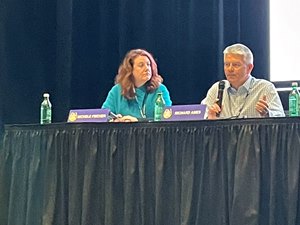HBPA Members See Great Potential in Fixed-Odds Wagering


A pair of executive directors for Horsemen's Benevolent and Protective Association state affiliates believe fixed-odds wagering has the potential to bring in significant new customers from attractive demographics (as in younger) while also improving the wagering product for existing customers.
Speaking on a panel at the National HBPA conference March 3 at the Oaklawn Park hotel in Hot Springs, Ark., Dave Basler, executive director of the Ohio HBPA, and Ed Fenasci, executive director of the Louisiana HBPA, each said they believe fixed-odds wagering on horse racing can grow the sport.
Fenasci noted that when looking at international wagering on horse racing, younger players prefer the fixed odds approach. In fixed odds, if a player bets a horse at 6-1, that price is locked in by a bookmaker, as opposed to pari-mutuel wagering, where the price on the horse fluctuates based on the amount of money wagered on each horse in the field until the gates open.
"This appeals to the ever-elusive younger horse race wagerer," Fenasci said, noting the topic of reaching younger players has been a topic at countless racing conferences over the past 25 years. "This is one of the aspects of fixed-odds wagering that most excites me because it gets back to the excitement of horse racing to a much larger customer base."
Basler also sees great potential for fixed-odds wagering to reach new customers and he also noted that the flexibility of fixed-odds wagering, compared with pari-mutuel wagering, has the potential to deliver a more exciting wagering product to existing customers.
"There's some opportunities for enhanced wagering in the U.S. We've talked offline about some of the things that could happen," Basler said. "Say you have a graded stakes race with just six horses and a 3-5 favorite in there; there's a good chance that the bookmaker is going to take that 3-5 shot out of the pool entirely and price everybody else as if that horse weren't in the race. So it makes an unbettable race bettable for people and potentially greatly increases our handle.

"There's a lot of different things that we don't have the ability to offer in pari-mutuel pools that fixed-odds wagering can offer and perhaps enhance our product."
Richard Ames, CEO of SIS, which supplies fixed-odds signals to bookmakers throughout the world and hopes to begin offering U.S. racing signals within the U.S., noted that some 30 states now offer sports wagering since the 2018 Supreme Court decision that opened that market. He said the top sports betting platforms have spent billions in advertising, marketing, and promotions to bring in new players.
He believes racing can best take advantage of that significant push through fixed-odds wagering as those are the types of wagers that sports bettors are familiar with playing.
Horsemen, of course, are concerned with getting the pricing right on fixed-odds wagering. Consultant Michele Fischer shared a pricing model that would see a fixed-odds wagering fee of 3.5%-to-4% of turnover charged to the bookmakers, of which 2% would go to the track and purses and 1% to the distributor. The remaining 0.5%-to-1% would be source-market fees to the local track based on where the wager is made, again to be split between the track and horsemen.
Basler encouraged state horsemen's groups to initially negotiate one-year deals to monitor wagering trends and note how much the fixed-odds wagering impacts the pari-mutuel pools. The hope is that even though the pari-mutuel pools will be impacted, there can be enough growth on the fixed-odds side to counter any losses there.
While brick-and-mortar locations are fine for fixed-odds wagering on racing, Ames noted that the players racing wants are playing on mobile sports betting apps. Based on his international experience, he said those platforms would be interested in fixed-odds wagering on U.S. races because they know customers want bet types not available on the tote system—including parlays combining racing with other sports, quick betting opportunities, and content that runs 24-7 from around the world. He noted the bet takers also typically enjoy a higher margin on racing than other sports.
Basler and Fenasci both see fixed-odds wagering as a way of getting racing in front of a new, younger audience.
"This is the greatest sport in the world. It was the greatest sport 35 years ago when I got into it, and it's still the greatest sport in the world today," Basler said. "I think that's what we need to focus on, and the fact that we can get the greatest sport in the world out in front of the new generation that hasn't seen it. We saw in the pandemic when horse racing came back first that if we get people exposed to it they enjoy it. That hasn't stopped. Last year our handle was up way over pre-pandemic levels.
"That's because new people got exposed to the sport. We've got to keep exposing this sport to people."
Fenasci added, "Fixed-odds wagering is very appealing to me. This is going to begin a new revenue stream directly tied to live racing. This is just something that will be communicating that racing excitement to a whole new customer base."
